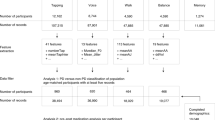Abstract
Smartphone-based assessments have been considered a potential solution for continuously monitoring gait and mobility in mild to moderate Parkinson’s disease (PD) patients. Forty-four PD patients from cohorts 4 to 6 of the Multiple Ascending Dose (MAD) study of PRX002/RG7935 and thirty-five age- and gender-matched healthy individuals (i.e. healthy controls - HC) in a separate study performed smartphone-based assessments for up to 24 weeks and up to 6 weeks, respectively. The assessments included “active gait tests”, where all participants were asked to walk for 30 s with at least one 180\(^\circ \) turn, and “passive monitoring”, in which subjects carried the smartphone in a pocket or fanny pack as part of their daily routine. In total, over 6,600 active gait tests and over 30,000 h of passive monitoring data were collected. A mobility analysis indicates that patients with PD are less mobile than HCs, as manifested in time spent in gait-related activities, number of turns and sit-to-stand transitions, and power per step. It supports the potential use of smartphones for continuous mobility monitoring in future clinical practice and drug development.
Access this chapter
Tax calculation will be finalised at checkout
Purchases are for personal use only
Similar content being viewed by others
References
Ramaker, C., Marinus, J., Stiggelbout, A.M., van Hilten, B.J.: Systematic evaluation of rating scales for impairment and disability in Parkinson’s disease. Mov. Disord. 17(5), 867–876 (2002)
González, R.C., López, A.M., Rodriguez-Uría, J., Álvarez, D., Alvarez, J.C.: Real-time gait event detection for normal subjects from lower trunk accelerations. Gait Posture 31, 322–325 (2010)
Zijlstra, A., Zijlstra, W.: Trunk-acceleration based assessment of gait parameters in older persons: a comparison of reliability and validity of four inverted pendulum based estimations. Gait Posture 38(4), 940–944 (2013)
Godfrey, A., Lord, S., Galna, B., Mathers, J.C., Burn, D.J., Rochester, L.: The association between retirement and age on physical activity in older adults. Age Ageing 43, 386–393 (2014)
Del Din, S., Godfrey, A., Galna, B., Lord, S., Rochester, L.: Free-living gait characteristics in ageing and Parkinson’s disease: impact of environment and ambulatory bout length. J. NeuroEng. Rehabil. 13, 46 (2016)
ClinicalTrials.gov. https://clinicaltrials.gov
Rai, A., Chintalapudi, K.K., Padmanabhan, V.N., Sen R.: Zee: zero-effort crowdsourcing for indoor localization. In: MobiCom (2012)
Ordóñez, F.J., Roggen, D.: Deep convolutional and LSTM recurrent neural networks for multimodal wearable activity recognition. Sensors 16, 115 (2016)
Weiss, G.M., Lockhart J.W.: The impact of personalization on smartphone-based activity recognition. In: Proceedings of the AAAI-12 Workshop on Activity Context Representation: Techniques and Languages, Toronto, Canada (2012)
Stisen, A., et al.: Smart devices are different: assessing and mitigating mobile sensing heterogeneities for activity recognition. In: 13th ACM Conference on Embedded Networked Sensor Systems, Seoul, Korea (2015)
Zijlstra, A., Mancini, M., Lindermann, U., Chiari, L., Zijlstra, W.: Sit-stand and stand-sit transitions in older adults and patients with Parkinson’s disease: event detection based on motion sensors versus force plates. J. NeuroEng. Rehabil. 9, 75 (2012)
El-Gohary, M., et al.: Continuous monitoring of turning in patients with movement disability. Sensors 14, 356–369 (2014)
Mancini, M., et al.: Continuous monitoring of turning in Parkinson’s disease: rehabilitation potential. NeuroRehabilitation 37(1), 3–10 (2015)
Lee, H.H., Choi, S., Lee, M.J.: Step detection robust against the dynamics of smartphones. Sensors 15(10), 27230–27250 (2015)
Pham, M.H.: Algorithm for turning detection and analysis validated under home-like conditions in patients with Parkinson’s disease and older adults using a 6 degree-of-freedom inertial measurement unit at the lower back. Front. Neurol. 8, 135 (2017)
Stack, E., Ashburn, A.: Dyscuntional turning in Parkinson’s disease. Disabil. Rehabil. 30(16), 1222–1229 (2008)
Acknowledgements
We thank Max A. Little for his technical input at the early stages of this research project.
Author information
Authors and Affiliations
Corresponding author
Editor information
Editors and Affiliations
Rights and permissions
Copyright information
© 2018 ICST Institute for Computer Sciences, Social Informatics and Telecommunications Engineering
About this paper
Cite this paper
Cheng, WY. et al. (2018). Large-Scale Continuous Mobility Monitoring of Parkinson’s Disease Patients Using Smartphones. In: Perego, P., Rahmani, A., TaheriNejad, N. (eds) Wireless Mobile Communication and Healthcare. MobiHealth 2017. Lecture Notes of the Institute for Computer Sciences, Social Informatics and Telecommunications Engineering, vol 247. Springer, Cham. https://doi.org/10.1007/978-3-319-98551-0_2
Download citation
DOI: https://doi.org/10.1007/978-3-319-98551-0_2
Published:
Publisher Name: Springer, Cham
Print ISBN: 978-3-319-98550-3
Online ISBN: 978-3-319-98551-0
eBook Packages: Computer ScienceComputer Science (R0)




